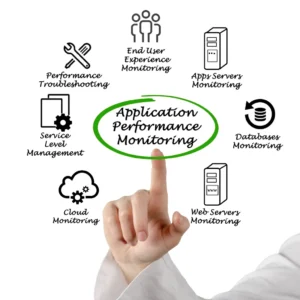
Cognitive Automation Unleashed
Navigating Intelligent Process Automation (IPA) with Innovation, Ethics, and Efficiency
Embarking on the transformative journey of “Cognitive Automation in Intelligent Process Automation (IPA),” this article explores the intricate facets that propel automation beyond mere efficiency.
Delving into the realms of Cognitive Process Identification, Natural Language Processing, Machine Learning Integration, Computer Vision, Cognitive Decision-Making, Security Measures, Human-Centric Design, Governance, Performance Metrics, and Ethical Practices, we unravel the key elements shaping the future of automation.
Each section caters to both business and technical audiences, identifying processes for cognitive augmentation and implementing security measures.
This guide navigates the technical intricacies and emphasizes the ethical and human-centric dimensions essential for responsible deployment.
Join us on this insightful journey as we delve into the multifaceted landscape of Cognitive Automation, where innovation converges with ethics to redefine the essence of Intelligent Process Automation.
Cognitive Process Identification
Unlocking Cognitive Automation Potential in IPA: A Comprehensive Approach to Process Identification
Identifying processes amenable to cognitive automation within Intelligent Process Automation (IPA) requires a strategic blend of techniques and criteria. Strategic Techniques for Identifying Processes Suited for Cognitive Automation in IPA involve comprehensive analysis, leveraging stakeholder insights, and considering the intricacies of each workflow.
An evaluation based on complexity, rule-based nature, and potential business impact is required to select processes compatible with cognitive automation. Balancing Rule-Based and Cognitive Decision-Making in Process Identification ensures optimal outcomes in diverse scenarios, fostering a harmonious integration of both approaches.
Feasibility Studies and Initial Assessments for Cognitive Automation Potential are imperative steps. Dynamic Protocols for Continuous Assessment of Cognitive Automation Suitability facilitate ongoing refinement based on changing business landscapes and technological advancements.
User-Centric Design Principles play a crucial role in optimizing the experience. Proactive Identification of Opportunities for Machine Learning in Process Identification ensures an adaptive approach, harnessing the power of machine learning for enhanced decision-making.
Governance Frameworks for Ethical and Transparent Cognitive Process Identification instil accountability and transparency. Ensuring Security and Compliance in Identifying Processes for Cognitive Automation is paramount, safeguarding sensitive data and complying with regulations.
In conclusion, a holistic approach intertwining strategic techniques, innovative criteria, user-centric design, and robust governance ensures the identification of processes ripe for cognitive automation, fostering a seamless integration within IPA.
Natural Language Processing (NLP) Applications
Harnessing the Power of NLP in Cognitive Automation for IPA
Integrating Natural Language Processing (NLP) into Intelligent Process Automation (IPA) elevates language understanding and interaction capabilities. Integrating Natural Language Processing (NLP) for Advanced Language Understanding in IPA lays the foundation for nuanced comprehension, enabling systems to grasp the intricacies of human communication.
Developing Chatbots and Virtual Assistants with NLP Capabilities in Automation ensures seamless human-machine interactions, fostering efficiency. NLP-Driven Document Processing and Information Extraction for Enhanced Automation streamlines data extraction, enhancing information accessibility within automated workflows.
Balancing Automation and Human Oversight in NLP Applications for IPA workflow is essential for maintaining accuracy and context awareness. Dynamic Approaches to Multilingual NLP expand language capabilities, facilitating broad linguistic understanding in diverse contexts.
Governance Frameworks for Ethical and Transparent NLP Integration Practices instil accountability and responsible use. Proactive Strategies for Ensuring Accuracy and Context Awareness in NLP Applications optimize performance, aligning systems with user expectations.
User-centric design Principles optimize user interaction, ensuring a seamless and intuitive experience in NLP-enhanced processes. Adaptive NLP Models for Continuous Learning and Improved Language Understanding enable systems to evolve and adapt over time.
Security Measures in NLP Integration: Protecting Sensitive Textual and Verbal Data safeguards against potential breaches, prioritizing the confidentiality of textual and verbal information. In conclusion, the strategic incorporation of NLP in IPA advances language capabilities and demands ethical governance, continuous learning, and user-centric design for harmonious human-machine collaboration.
Machine Learning Integration
Elevating Decision-Making: Machine Learning Integration in Cognitive Automation
The strategic integration of Machine Learning (ML) within Intelligent Process Automation (IPA) amplifies decision-making capabilities. Strategic Integration of Machine Learning for Advanced Decision-Making in IPA involves identifying optimal opportunities for ML implementation, ensuring a symbiotic relationship between human expertise and automated processes.
Feasibility Studies and Initial Assessments for Machine Learning Integration are crucial initial steps in determining the viability and potential impact of ML in specific automation scenarios. Innovative Approaches to Data Labeling and Annotation for Training Data Sets enhance the quality and relevance of training data, fortifying ML models for cognitive decision-making.
Balancing Automation and Human Oversight in Machine Learning Integration Processes is essential for maintaining accuracy and accountability. Dynamic Strategies for Continuous Learning and Adaptation in Machine Learning Models ensure ongoing refinement, fostering adaptability in response to evolving business dynamics.
Governance Frameworks for Ethical and Transparent Machine Learning Practices in IPA uphold ethical standards and transparency. User-Centric Design Principles enhance user experiences within ML-enhanced automation, aligning technology with human needs.
Proactive Error Detection and Resolution Protocols in Machine Learning Integration preemptively address potential issues, minimizing disruptions. Adaptive Protocols for Iterative Enhancements Based on Machine Learning Insights drive continuous improvement, harnessing the insights generated by ML models.
Ensuring Data Privacy and Compliance in Machine Learning-Driven Automation Processes safeguards sensitive information, adhering to regulatory requirements. In conclusion, the seamless integration of Machine Learning in IPA demands a holistic approach, encompassing ethical governance, user-centric design, and continuous adaptation for enhanced decision-making and user satisfaction.
Computer Vision and Image Recognition
Visionary Integration: Computer Vision and Image Recognition in Cognitive Automation
Unlocking the potential of Computer Vision and Image Recognition within Intelligent Process Automation (IPA) heralds a new era in workflow enhancement. Computer Vision in Intelligent Process Automation workflow encompasses visual pattern recognition and cue interpretation, revolutionizing task execution.
Strategic Integration of Image Recognition for Enhanced Automation Capabilities empowers systems to identify and respond to visual cues, fostering efficiency. In automation, novel methods of processing and interpreting visual data revolutionize information extraction from images, optimizing data utilization.
Balancing Automation and Human Oversight in Computer Vision and Image Recognition ensures accuracy and accountability. Dynamic Protocols for Identifying and Responding to Visual Patterns and Cues enable systems to adapt to changing visual contexts in real time.
Governance Frameworks for Ethical and Transparent Computer Vision Practices in IPA establish ethical standards and transparency. User-centric design Principles optimize user experiences, ensuring a seamless interaction in processes enhanced by image recognition.
Proactive Error Detection and Resolution Protocols in Computer Vision Integration preemptively address potential issues, minimizing disruptions. Adaptive Protocols for Iterative Enhancements Based on Visual Data Insights drive continuous improvement, leveraging insights derived from visual data.
Ensuring Security and Compliance in Computer Vision and Image Recognition Processes safeguards against unauthorized access and ensures compliance with industry regulations. In conclusion, the harmonious integration of Computer Vision and Image Recognition in IPA transforms workflows and demands ethical governance, user-centric design, and continuous adaptation for a secure and efficient automation landscape.
Cognitive Decision-Making Processes
Unleashing Cognitive Decision-Making in Intelligent Process Automation
Implementing Cognitive Decision-Making in Intelligent Process Automation (IPA) heralds a transformative era in automated workflows. Balancing Automation and Human Oversight in Cognitive Decision-Making workflow ensures a harmonious integration, combining the strengths of automated processes with human expertise.
Strategic Protocols for Ethical and Transparent Decision-Making Practices in IPA establish ethical standards and transparency, which are crucial for fostering trust. Innovative Approaches to Collaboration Between Human and Cognitive Decision Systems optimize collaboration, leveraging the unique strengths of each.
Dynamic Strategies for Incorporating Cognitive Insights into Decision-Making Processes facilitate real-time adaptation to evolving scenarios, enhancing decision accuracy. Governance Frameworks for Ensuring Fairness and Accountability in Cognitive Decisions uphold principles of fairness and accountability, mitigating biases.
User-Centric Design Principles enhance user experiences, ensuring a seamless interaction in decision-making processes. Proactive Error Detection and Resolution Protocols in Cognitive Decision-Making preemptively address potential issues, minimizing disruptions.
Adaptive Protocols for Iterative Enhancements Based on Cognitive Decision Insights drive continuous improvement, leveraging insights derived from cognitive decision processes. Ensuring Transparency and Explainability in Cognitive Decision-Making Processes establishes a clear understanding of automated decisions, building confidence and understanding.
In conclusion, integrating Cognitive Decision-Making in IPA augments decision capabilities and demands ethical governance, user-centric design, and continuous adaptation for a transparent, efficient, and accountable decision-making landscape.
Cognitive Automation Security Measures
Safeguarding Cognitive Automation: Security Measures in IPA
Implementing Cognitive Automation in Intelligent Process Automation (IPA) necessitates robust security measures. Strategic Security Protocols for Protecting Sensitive Cognitive Data in Automation establish safeguards to shield critical information from unauthorized access.
Feasibility Studies and Initial Assessments for Cognitive Automation Security are foundational in determining the security landscape and potential vulnerabilities. Balancing Automation and Human Oversight in Security Measures for Cognitive Processes ensures a vigilant combination of automated surveillance and human intervention.
Dynamic Strategies for Ensuring Privacy and Compliance in Cognitive Automation navigate the complexities of privacy regulations, fostering compliance. Innovative Approaches to the Ethical and Transparent Use of Cognitive Technologies prioritize ethical considerations, promoting responsible and transparent use.
Governance Frameworks for Security in Cognitive Automation Practices in IPA provide a structured approach, ensuring security protocols align with industry standards. User-centric design Principles optimize security in human-cognitive interactions, prioritizing user experience and security hand in hand.
Proactive Risk Mitigation Strategies Based on Security Insights in Cognitive Automation preemptively address potential threats, minimizing risks. Adaptive Protocols for Iterative Enhancements Based on Cognitive Security Insights drive continuous improvement, staying ahead of evolving security challenges.
Ensuring the Security of Data at Rest, in Transit, and during Processing in Cognitive Automation workflow encompasses a comprehensive security strategy, safeguarding data throughout its lifecycle. In conclusion, secure Cognitive Automation demands a multifaceted approach, integrating ethical, transparent, and adaptive security practices for a resilient automation landscape.
Human-Centric Cognitive Automation
Elevating Human-Centric Cognitive Automation in IPA
Human-centric cognitive Automation within Intelligent Process Automation (IPA) prioritizes user experience and collaboration. Designing Human-Centric Interfaces for Seamless Collaboration with Cognitive Bots ensures intuitive and collaborative interfaces, fostering a natural interaction between humans and automation.
Proactive Strategies for Integrating Human Oversight in Complex Decision-Making strike a balance between automation and human involvement. Dynamic Protocols for Ensuring Transparency and Trust in Human-Centric Processes establish clear communication, addressing user concerns and building trust in cognitive automation.
Innovative Approaches to User-Friendly Interaction in Human-Centric Cognitive Bots optimize the user experience, making interactions intuitive and efficient. Governance Frameworks for Ethical and Transparent Human-Centric Cognitive Practices set ethical standards, ensuring transparency and accountability in human-bot collaboration.
User-centric design Principles for Enhancing User Experience in Human-Bot Collaboration focus on creating processes prioritizing user needs. Adaptive Protocols for Iterative Enhancements Based on Human-Centric Insights drive continuous improvement, incorporating user feedback into the evolution of automation.
Ensuring Security and Compliance in Human-Centric Cognitive Automation workflow safeguard sensitive information, adhering to regulatory requirements. Strategic Human Feedback Mechanisms for Continuous Improvement in Cognitive Processes establish feedback loops, allowing humans to contribute to refining cognitive processes.
In conclusion, integrating human-centric principles in cognitive automation enhances user satisfaction and demands ethical governance, transparency, and continuous improvement for seamless collaboration between humans and cognitive bots.
Cognitive Automation Governance
Orchestrating Ethical Cognitive Automation Governance in IPA
Developing Governance Frameworks for Ethical and Transparent Cognitive Automation is paramount in Intelligent Process Automation (IPA). Balancing Automation and Human Oversight in the Governance of Cognitive Automation Processes ensures responsible decision-making, harmonizing machine efficiency with human wisdom.
Strategic Protocols for Compliance with Regulations and Standards in Cognitive Automation guarantee adherence to legal and industry norms, mitigating risks. Innovative Approaches to Oversight and Auditing of Cognitive Automation Implementations implement thorough checks, assuring system reliability and ethical use.
Dynamic Governance Strategies for Addressing Bias and Ensuring Fairness in Automation counteract biases, promoting fairness. User-centric design Principles for Governance Protocols Optimized for User Experience prioritize user-friendly interfaces that align with ethical governance.
Proactive Implementation of Ethical Guidelines for Responsible Use of Cognitive Technologies instils a proactive ethical stance. Adaptive Governance Protocols for Iterative Enhancements Based on Cognitive Insights ensure continual improvement, adapting to emerging challenges and insights.
Ensuring Security and Compliance Within Governance Frameworks for Cognitive Automation safeguard sensitive information. Collaborative Platforms and Tools for Implementing and Managing Cognitive Automation Governance facilitate collaborative efforts in upholding ethical standards and compliance.
In summary, robust governance in cognitive automation demands strategic frameworks, compliance protocols, oversight innovations, and a user-centric ethical approach, fostering responsible and transparent use in the evolving landscape of IPA.
Cognitive Automation Performance Metrics
Precision in Motion: Cognitive Automation Performance Metrics in IPA
Precision in Cognitive Automation within Intelligent Process Automation (IPA) demands a strategic approach to performance metrics. Establishing Key Performance Indicators (KPIs) for Cognitive Processes in Automation lays the foundation for measurement and improvement.
Dynamic Metrics for Continuous Monitoring and Optimization of Cognitive Automation ensure adaptability to evolving business needs. Innovative Approaches to Evaluating the Impact and Efficiency of Cognitive Automation provide insights into the system’s contribution to overall business efficiency.
Balancing Automation and Human Oversight in Performance Metrics for Cognitive Processes guarantees a holistic perspective, combining the strengths of automation and human intervention. Strategic Measurement of User Satisfaction and Experience in Cognitive Automation ensures that the end-users experience seamless and satisfactory interactions.
Governance Frameworks for Ethical and Transparent Performance Metric Practices in IPA establish ethical standards, fostering transparency in performance evaluations. Proactive Consideration of Cognitive Automation’s Impact on Business Process Efficiency anticipates potential impacts, optimizing processes for enhanced efficiency.
Adaptive Protocols for Iterative Enhancements Based on Performance Metric Insights drive continual improvement. Ensuring Accuracy and Consistency in Cognitive Automation Performance Measurement safeguards against errors, ensuring reliable insights.
Collaborative Platforms and Tools for Implementing and Managing Cognitive Performance Metrics facilitate collaborative efforts, enabling efficient management and implementation of performance measurement standards. In conclusion, the dynamic and precise evaluation of cognitive automation performance is integral to achieving optimal efficiency in IPA workflows.
Ethical and Responsible AI Practices
Upholding Ethics in Cognitive Automation for IPA
Implementing Ethical and Responsible AI Practices in Intelligent Process Automation (IPA) is imperative for fostering fairness and transparency. Balancing Automation and Human Oversight for Ethical Decision-Making in IPA ensures a harmonious integration of machine intelligence with human judgment.
Dynamic Strategies for Transparent AI Decision-Making and Explainability establish clear communication, fostering trust. Governance Frameworks for Ethical and Transparent AI Practices in IPA set ethical standards, ensuring responsible use and transparency in AI-driven processes.
Proactive Identification and Mitigation of Risks to Ethical AI Decision-Making minimizes potential ethical risks, promoting proactive risk management. User-centric design Principles for Enhancing User Experience in Ethical AI Interaction prioritize user satisfaction and understanding in AI-driven interactions.
Adaptive Protocols for Iterative Enhancements Based on Ethical and Responsible AI Insights drive continual improvement, adapting to emerging ethical challenges. Ensuring Compliance with Ethical Guidelines and Standards in AI-driven automation safeguards against ethical violations, ensuring alignment with industry standards.
In conclusion, the ethical foundation of cognitive automation demands strategic, innovative, and adaptive approaches, fostering responsible use, transparency, and fairness in the evolving landscape of IPA.
Conclusion
In the “Cognitive Automation in Intelligent Process Automation (IPA),” the convergence of innovation and ethics is the defining feature.
This comprehensive guide has traversed the intricate domains of automation, from identifying processes suitable for cognitive augmentation to implementing security measures and ensuring ethical governance.
As we conclude this exploration, the importance of harmonizing technological prowess with ethical considerations becomes abundantly clear. Integrating Natural Language Processing, Machine Learning, Computer Vision, and Cognitive Decision-Making has ushered in a new era of efficiency and intelligence.
Strategic design principles and user-centric approaches emphasize the technical finesse and the human experience in these automated landscapes. Governance frameworks and ethical guidelines have been underscored as indispensable, ensuring transparency, fairness, and regulation compliance.
This journey through Cognitive Automation underscores the continuous need for adaptation and improvement. Dynamic strategies, adaptive protocols, and proactive measures are the foundation for iterative enhancements, fostering an efficient and ethically sound landscape.
As we embrace the future of Intelligent Process Automation, let this guide be a compass, steering towards a harmonious synergy of technological advancement and responsible practices in the ever-evolving world of cognitive automation.
Related Articles
- Choosing the Right Automation Tool in 7 Steps
- A 9-Step Guide to IPA Implementation: Energise Your Operations
- Navigating the Roadblocks of IPA – The Top 9 Challenges
- AI in Intelligent Process Automation – Unleash the Power of AI
- 9 IPA Examples in Small-Scale Industries
- Power of Intelligent Business Process Automation – Efficiency
- AI Business Process Management: Unleashing the Power
- Business Process Management with AI Integration
- AI for Reengineering Business Processes
- Hyperautomation: Redefining BPM with AI
- The Role of AI in Business Process Modelling
- AI-driven Customer Onboarding – Unleash the Power of AI
- Effective Process mapping in Intelligent Process Automation
- Intelligent Process Automation Adoption – The Best Strategy Guide
- TechInfra in IPA: A Comprehensive Guide
- Elevating Intelligent Automation with Continuous Improvement
- Comprehensive Approach to Cost-Benefit Analysis in IPA
- Vendor Selection in IPA – Comprehensive Guide
- Implementing Agile in Intelligent Process Automation (IPA)
- Scalability and Integration in Intelligent Process Automation
- Cognitive Automation in IPA: Innovating Ethical Efficiency
- Mastering Symphony: Bot Development in IPA Unveiled
- UI/UX Mastery in IPA: Elevating Automation Experiences
- Compliance and Security in IPA – A Guide Ensuring Trust
- Impact of Performance Monitoring and Analytics in IPA
- Driving Success: Data Management in IPA
- Crucial Role: Documentation in IPA Triumph
- Optimizing IPA – Continuous Improvement Strategies




































